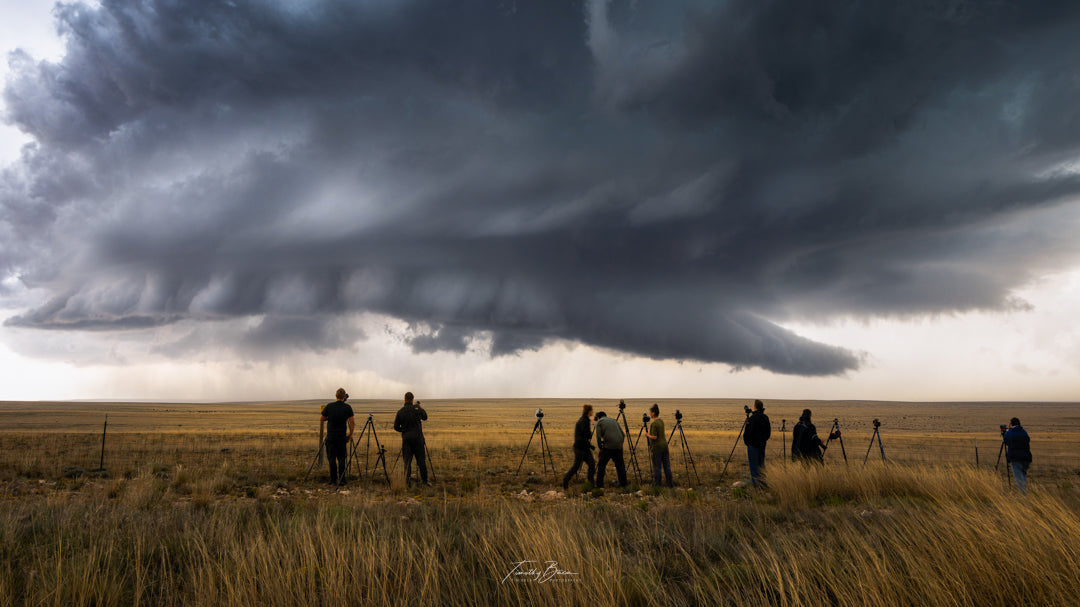About The Experience

Instruction Style
Extreme Photo Workshops is not your typical photography workshop. Storm photography is fast-paced and unpredictable, with a subject that is constantly moving and changing. To get the most out of the experience, participants should feel comfortable with their cameras, tripods, and other gear; know how to shoot in manual mode; and understand the basics of how ISO, aperture, and shutter speed work together.
During the workshop, our pros will guide you and help you fine-tune your settings for each scene, point out compelling compositional elements, and share insight into forecasting and storm structure. We’re always available to answer questions, but we believe the best way to learn is by doing. You’ll have the freedom to experiment, explore your creativity, and capture images that are uniquely your own.
This is not a workshop where the instructor sets up your camera and frames the shot for you. Instead, our goal is to give you the skills, knowledge, and confidence to photograph storms independently with just the right amount of support along the way.
Daily Schedule
The itinerary will depend on severe weather and each day's chase setup. There is no set or planned schedule for every day. We make our decisions based on real-time forecasting and meteorological data which can change quickly. It's normal to travel 100 miles or more during a single chase. Clients should be prepared to drive long distances and spend many hours in the vehicle as we search for the most stunning supercells. Since we go where the severe weather risk is greatest, one day we might be in Texas and the next day traveling to South Dakota.
Storms normally fire in the late afternoon or early evening, and we will often chase into the night. Expect late-night arrivals to hotels (sometimes after midnight) and early wake-up calls depending on our driving distance and the next day's forecast. Meal times may also be irregular due to the unpredictable nature of storm chasing and fast food is often the only option available when a chase is finished. Sometimes a meal may look like picking up something quick at a gas station.
Storm chasing involves a lot of waiting before storms mature and the chase begins. We arrive at target locations a few hours before storms fire to ensure the best positioning. During downtime, we will try our best to find entertaining things to do. However, most chases happen in rural parts of the country. We encourage all guests to bring a laptop or tablet, books, headphones, etc. for entertainment.
Accommodations
Vehicle
Travel is in a spacious eight-passenger SUV similar to a Chevy Suburban or Jeep Wagoneer. To ensure comfort, there will never be more than six people in the vehicle at any time. The SUV is fully equipped with multiple USB ports for charging phones, a power strip for laptops and other devices, and Starlink wifi.
Luggage is limited to one carry-on sized bag and one camera bag. This ensures all luggage and gear fits comfortably inside the vehicles. All camera gear will remain with guests in the SUV, while personal luggage will travel in a dedicated follow car driven by our lead Thomas Knepshield.
Hotels
We take care of all lodging arrangements for you. We book mid-range properties rated 8.0 or higher on Hotels.com, so you can expect a comfortable and reliable stay each night. Because storm chasing can take us to unexpected places, our end-of-day location often determines where we stay. Sometimes we book hotels in advance, while other times we wait until the chase is over to make reservations. On occasion, this may mean staying in a smaller town with more limited options or driving a bit farther to find available rooms. We always do our best to secure the best accommodations possible for the group.
"Severe Clear" Plans
Our workshop depends on climatological patterns and the atmosphere. We plan our workshops during the most historically active weeks for severe weather, but occasionally the large-scale pattern can become unfavorable for frequent supercells.
On days where no storms are expected we will explore other types of photography including landscape and astro or find recreational activities in different areas. We may also use this time for image reviews and post-processing sessions.
We often find ourselves in the vicinity of many beautiful national parks and have visited Badlands National Park in South Dakota, Devil's Tower in Wyoming, White Sands National Park in New Mexico, and more.
